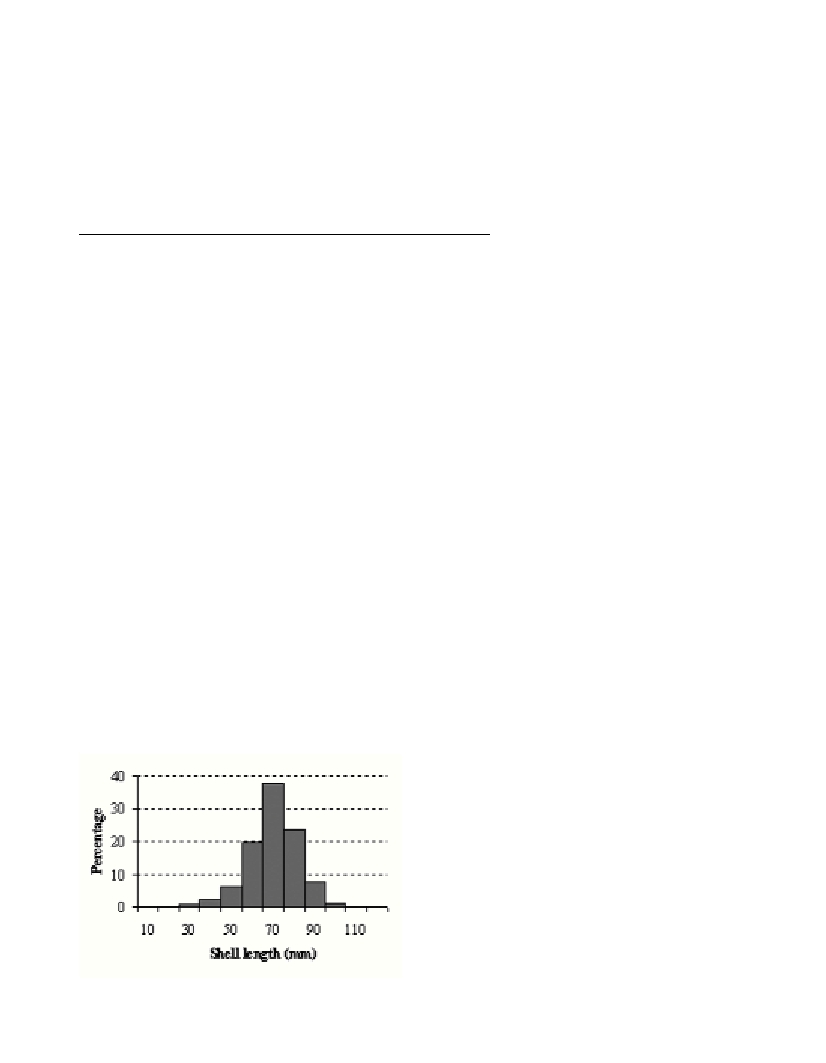EVALUATION OF THE PURPLE DYE MUREX BOLINUS BRANDARIS(MOLLUSCA: GASTROPODA)
POPULATION AS A NEW FISHERY RESOURCE IN THE GULF OF ROSES
(CATALAN COAST, NW MEDITERRANEAN)
Sandra Mallol
1*
, Marta Muñoz
2
, Mª Rosa Hernández
2
and Margarida Casadevall
2
1
IEO-Centre Oceanogràfic Balears, Palma de Mallorca, Spain - * sandra@ba.ieo.es
2
Àrea de Zoologia, Universitat de Girona, Campus Montilivi, Girona, Catalonia, Spain
Abstract
Length frequency distribution, sex ratio and catch per hour (CPUE) of Bolinus brandarissampled with a new gear design called the sweep
bottom turning gear in the Gulf of Roses (NW Mediterranean) were analysed. A total of 3754 specimens (shell length = 22.66-119.40 mm,
sex-ratio = 1:1.1 in favour of females, CPUE = 1.22-30.70 kg h
-1
) were measured from 36 experimental hauls.
Keywords: Bolinus brandaris, population, fisheries, north-western Mediterranean
Rapp. Comm. int. Mer Médit., 37,2004
394
Introduction
The purple dye murex, Bolinus brandaris, constitutes a resource of
local importance in different Mediterranean areas. Off the Catalan
coast (NW Mediterranean) this species can only be fished in the two
southernmost regions of Barcelona and Tarragona, using a type of
dragged gear. During recent years, incidental catches of B. brandaris
have been increasing in the Gulf of Roses (northern region of Catalan
coast) although there is no fishery targeting on this species. The local
fisher’s association requested permission from the authorities to
exploit this resource with a new gear design called the sweep bottom
turning gear or “radasses”. The aim of this study was to evaluate the
local B. brandarispopulation in view of its future exploitation.
Material and methods
Data were collected by onboard sampling during March-April 2001
in the Gulf of Roses. Thirty-six experimental hauls were performed by
commercial fishing vessels at a depth range of 9 to 50 m. The gear
used was the sweep bottom turning gear that consists of a trammel net
of 150 m long and 2 m high in which both the lower and upper lines
carry weights. In other words, the net has two lead lines that hold it
?at on the bottom. The stretched mesh size was 50 and 240 mm for
the inner and outer panels of the net respectively. The net was towed
from 1 to 3 hours and the towing speed was between 1 and 2 knots. A
representative sample of the catch was taken from each haul. The shell
length (SL, mm) and shell width (SW, mm) of every individual were
measured, with a precision of 0.1 mm, using an automatic vernier
caliper. Also the sex ratio of the sample and the total weight of the
catch of each haul were recorded. Available data on total monthly
landings of B. brandarisfrom the fishing port of Roses were used to
infer the evolution of the abundance during the last years.
Results and discussion
A total of 45896 individuals of B. brandarisweighting 754.44 kg
were caught. The CPUE (kg per hour) ranged between 1.22 and 30.70
kg h
-1
. A subsample of 3754 specimens was measured. The size of the
specimens ranged from 22.66 to 119.40 mm SL (mean ±S.E. = 70.80
±11.80 mm) (Fig. 1) and from 10.01 to 57.46 mm SW (mean ±S.E.
= 32.60 ±5.92 mm) respectively. The SL of females (N = 719) ranged
from 28.05 to 105.05 mm (mean ±S.E. = 70.79 ±11.47 mm) and that
of males (N = 647) ranged from 32.55 to 119.40 mm (mean ±S.E. =
70.84 ±10.62 mm). The sex was determined in 1366 specimens and
females comprised 52.64% of the sampled population. The SL range
and the mean SL reported here are higher than those reported for the
exploited population of Sant Carles de la Ràpita (SL range between 16
and 90 mm, mean SL = 52 mm) (as in 1).
The landings of B. brandarisshowed a pronounced seasonality. The
maximum landings during the year in Roses occurred in late spring
and early summer (May, June and July; 1000 kg/month) coinciding
with the ripening of the gonads and the spawning aggregations. Due
to the seasonal rotation of the artisanal fishery, the lowest landings
occurred in autumn coinciding with the resting phase of reproductive
cycle (September, October and November; 200-300 kg/month). This
contradicts a previous study that reported maximum landings in late
autumn and winter and minimum landings in summer (as in 1).
Commercial landings (landed catch per vessel, CPUE) exhibited an
increasing trend from 1994 to 2002 suggesting that the fishery has not
attained the maximum sustainable yield.
Our results showed a well structured length frequency distribution
of B. brandarisfrom Roses with specimens that surpassed the
100mm of shell length, an exceptional length for this species, result
of a non-exploited population.
References
1-Martín P., Sánchez P., and Ramón M., 1995. Population structure and
exploitation of Bolinus brandaris(Mollusca: Gasteropoda) off the Catalan
coast (north-western Mediterranean). Fish. Res.,23: 319-331.
Fig. 1. Shell length frequency distributions of Bolinus brandaris from
Gulf of Roses.

